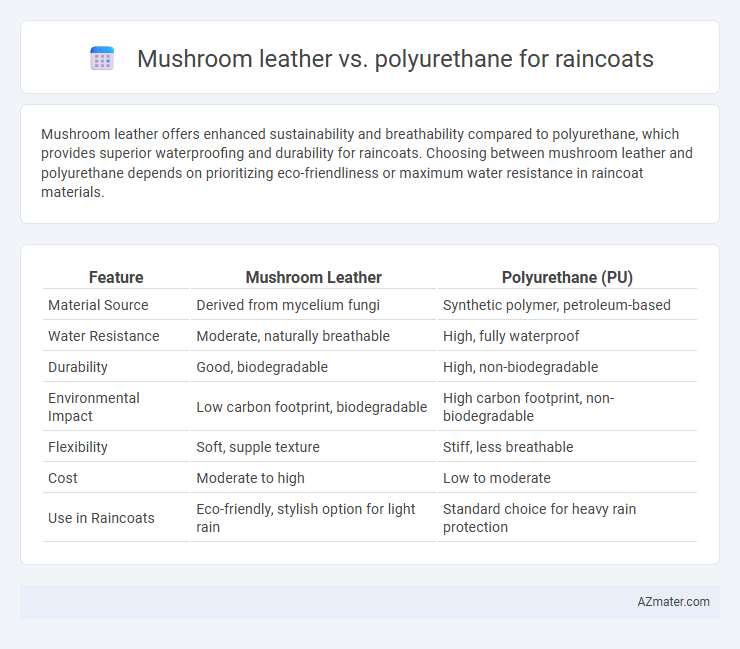Mushroom leather offers enhanced sustainability and breathability compared to polyurethane, which provides superior waterproofing and durability for raincoats. Choosing between mushroom leather and polyurethane depends on prioritizing eco-friendliness or maximum water resistance in raincoat materials.
Table of Comparison
| Feature | Mushroom Leather | Polyurethane (PU) |
|---|---|---|
| Material Source | Derived from mycelium fungi | Synthetic polymer, petroleum-based |
| Water Resistance | Moderate, naturally breathable | High, fully waterproof |
| Durability | Good, biodegradable | High, non-biodegradable |
| Environmental Impact | Low carbon footprint, biodegradable | High carbon footprint, non-biodegradable |
| Flexibility | Soft, supple texture | Stiff, less breathable |
| Cost | Moderate to high | Low to moderate |
| Use in Raincoats | Eco-friendly, stylish option for light rain | Standard choice for heavy rain protection |
Introduction to Sustainable Raincoat Materials
Mushroom leather, derived from mycelium, represents an eco-friendly alternative to traditional raincoat materials, offering biodegradability and reduced environmental impact compared to synthetic options like polyurethane. Polyurethane raincoats, while waterproof and durable, often rely on petroleum-based production processes that contribute to pollution and carbon emissions. Sustainable raincoat materials prioritize renewable resources and minimal ecological footprints, positioning mushroom leather as a promising innovation for environmentally conscious outerwear.
What is Mushroom Leather?
Mushroom leather, derived from the mycelium of mushrooms, offers a sustainable and biodegradable alternative to polyurethane for raincoats. This innovative material combines durability and water resistance with eco-friendly properties, reducing plastic pollution associated with synthetic options. Compared to polyurethane, mushroom leather provides breathability and a lower carbon footprint, making it a preferable choice for environmentally conscious outerwear.
Understanding Polyurethane (PU) Leather
Polyurethane (PU) leather is a synthetic material commonly used for raincoats due to its water-resistant and durable properties. Unlike traditional leather, PU leather is made by coating a fabric base with a polymer that mimics the texture and appearance of real leather while offering lightweight flexibility. Its breathability and ease of maintenance make PU leather a practical choice for rainwear, contrasting with the emerging use of mushroom leather, which emphasizes sustainability and biodegradability.
Environmental Impact: Mushroom Leather vs Polyurethane
Mushroom leather is a biodegradable and renewable material derived from mycelium, significantly reducing carbon footprint and landfill waste compared to polyurethane, which is petroleum-based and non-biodegradable. The production of mushroom leather consumes less water and energy, whereas polyurethane manufacturing involves toxic chemicals contributing to environmental pollution. Choosing mushroom leather over polyurethane for raincoats promotes sustainability by minimizing plastic waste and supporting eco-friendly resource cycles.
Durability and Weather Resistance Comparison
Mushroom leather, derived from mycelium, offers moderate durability with natural breathability but tends to degrade faster under prolonged moisture exposure compared to polyurethane (PU), which is highly durable and resistant to water. Polyurethane raincoats provide superior weather resistance, effectively repelling rain and wind while maintaining flexibility over time. Mushroom leather rainwear may require additional treatments for enhanced waterproofing, whereas PU inherently offers robust protection against harsh environmental conditions.
Comfort and Breathability for Raincoats
Mushroom leather offers superior breathability and natural moisture-wicking properties, enhancing comfort during prolonged wear in rainy conditions. Polyurethane raincoats, while waterproof and durable, tend to trap heat and limit airflow, often causing discomfort and sweating. The biodegradable and flexible nature of mushroom leather provides a more breathable and eco-friendly alternative to traditional polyurethane materials.
Aesthetic Appeal and Design Flexibility
Mushroom leather offers a unique, natural texture with subtle variations that enhance the visual appeal of raincoats, providing a modern yet organic aesthetic not commonly found in synthetic materials. Polyurethane allows for a wider range of colors, finishes, and surface patterns, giving designers greater flexibility to create sleek, glossy, or matte raincoats tailored to urban and sporty looks. The choice between mushroom leather's distinct, eco-friendly charm and polyurethane's customizable design options depends on the desired balance between natural elegance and vibrant, versatile styling.
Cost Analysis: Mushroom Leather vs Polyurethane
Mushroom leather, derived from sustainable mycelium, generally incurs higher production costs compared to polyurethane due to its eco-friendly cultivation process and limited scalability. Polyurethane offers a more affordable option for raincoats because of its mass production capabilities and lower raw material expenses. Despite the initial cost difference, mushroom leather provides long-term value through biodegradability and reduced environmental impact.
Biodegradability and End-of-Life Considerations
Mushroom leather offers superior biodegradability compared to polyurethane, breaking down naturally within months in composting conditions while polyurethane can persist for decades in landfills due to its synthetic polymer structure. End-of-life disposal for mushroom leather involves environmentally friendly composting processes, reducing landfill waste and minimizing toxic residue, whereas polyurethane requires energy-intensive recycling or contributes to microplastic pollution if discarded improperly. Choosing mushroom leather for raincoats supports circular economy principles through renewable sourcing and complete biodegradability, unlike polyurethane's reliance on fossil fuels and limited end-of-life options.
Future Trends in Eco-Friendly Rainwear
Mushroom leather, derived from mycelium, offers a sustainable and biodegradable alternative to polyurethane in raincoat manufacturing, significantly reducing environmental impact. Innovations in mushroom leather processing enhance water resistance and durability, positioning it as a leading material in future eco-friendly rainwear trends. Market demand for biodegradable textiles drives investment in mushroom leather technology, promising a shift from traditional synthetic raincoat materials towards renewable, low-carbon footprint alternatives.

Infographic: Mushroom leather vs Polyurethane for Raincoat
 azmater.com
azmater.com